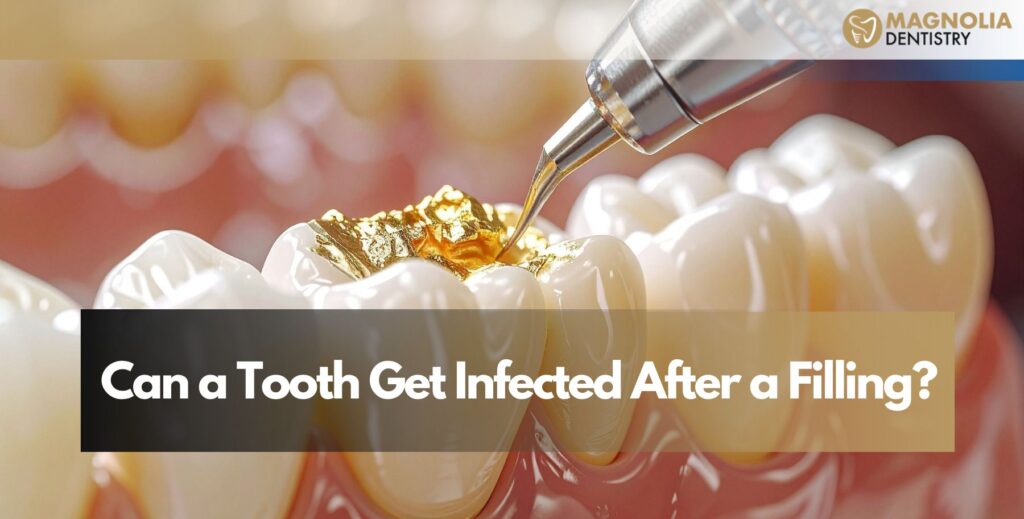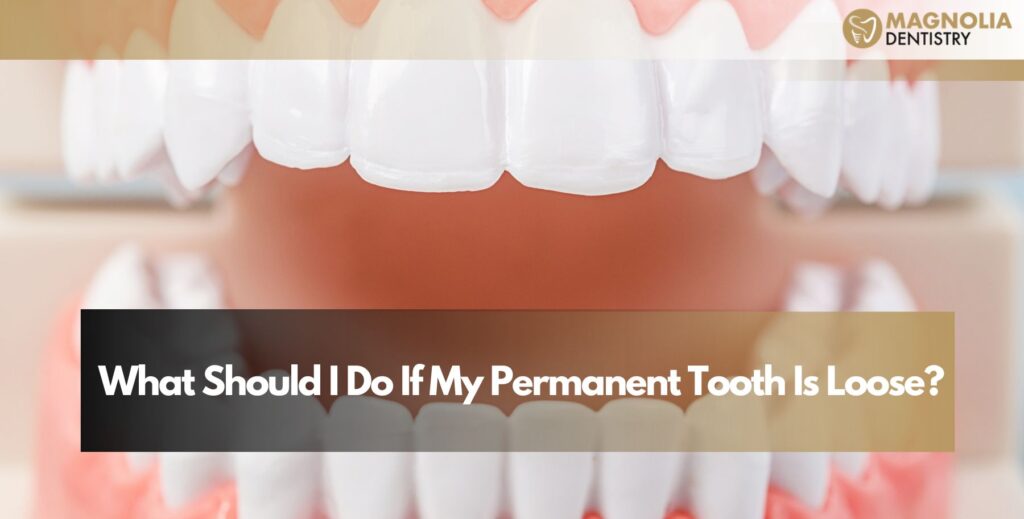Dental fillings are one of the most common treatments for cavities and minor tooth decay. They restore the tooth’s structure, prevent further damage, and help maintain your oral health. However, while fillings are meant to protect your teeth, sometimes complications can occur — including an infection.
Many patients ask, “Can a tooth get infected after a filling?” The short answer is yes, though it’s relatively uncommon when the procedure is done properly. An infection may develop if bacteria remain inside the tooth, if the filling leaks, or if decay progresses beneath the restoration.
At Magnolia Dentistry, we take extra care to ensure your fillings are done with precision, using high-quality materials and advanced sterilization to minimize any risk of infection. In this article, we’ll explore why an infected tooth filling happens, what the symptoms are, and how to treat and prevent it effectively.
Table of Contents
Understanding What Happens During a Dental Filling
Before diving into infections, it’s important to understand what a filling procedure involves. When you get a filling, your dentist removes decayed portions of the tooth, disinfects the area, and then seals it with a filling material — typically composite resin, porcelain, or amalgam.
This restoration protects your tooth from further decay and restores normal chewing function. However, if bacteria remain trapped beneath the filling or if the seal is not perfect, an infection can develop later on.
Infected Filling: How Does It Happen?
An infected filling occurs when bacteria infiltrate the inner layers of a tooth after a cavity has been filled. This can happen immediately after the procedure or develop months (even years) later.
Common Causes of an Infected Tooth Filling
- Residual Bacteria Before the Filling
If bacteria remain inside the tooth before the filling is placed, they can multiply and lead to infection after the procedure. - Leaking or Damaged Fillings
Over time, fillings may crack, chip, or shrink, creating gaps where bacteria can enter. This leakage often leads to an infection after tooth filling. - Deep Cavities or Root Exposure
When decay reaches close to the pulp (the soft tissue containing nerves and blood vessels), even a well-placed filling may not prevent infection. - Poor Oral Hygiene After Treatment
Failing to brush, floss, and rinse properly can allow bacteria to enter around the edges of the filling, resulting in reinfection.
Signs of Infection After Cavity Filling
Recognizing the signs of infection after cavity filling early can help you get prompt treatment and prevent more serious complications like abscess formation.
Persistent Pain or Sensitivity
Mild sensitivity after a filling is normal, but sharp, lingering pain may indicate an infection or nerve inflammation. If you experience pain when biting or chewing, it’s best to visit your dentist immediately.
Swelling or Tenderness Around the Tooth
Inflammation or swelling of the gums near the filled tooth can signal an infection spreading beneath the surface.
Tooth Discoloration or Bad Taste
If the tooth darkens, develops a foul taste, or produces bad breath, it could be a sign of bacterial activity under the filling.
Gum Boil or Pus Discharge
A small pimple-like bump on your gums near the filled tooth may indicate an abscess — a clear sign of infection after dental filling.
Fever or Jaw Discomfort
In severe cases, an untreated infection can spread beyond the tooth, leading to fever, swollen lymph nodes, and jaw pain.
If you notice any of these symptoms, don’t delay treatment — an infected filling won’t heal on its own.
Infection After Tooth Filling: Why It Shouldn’t Be Ignored
An infection after tooth filling can lead to serious complications if left untreated. The bacteria can spread to nearby teeth, gums, and even into the bloodstream, causing a condition known as tooth abscess.
Potential Complications Include:
- Bone Loss: Infection can spread to the jawbone, weakening its structure.
- Tooth Loss: Severe infections may destroy the surrounding tissues, requiring tooth extraction.
- Chronic Pain: Ongoing inflammation can irritate surrounding nerves, causing persistent discomfort.
Timely diagnosis and professional dental care can stop the infection before it progresses.
How Is an Infected Tooth Filling Treated?
At Magnolia Dentistry, we customize your treatment plan depending on the severity and location of the infection.
Deep Cleaning and Replacement of Filling
If the infection is mild, your dentist may remove the old filling, clean out any decayed or infected tissue, and place a new filling to reseal the tooth.
Root Canal Therapy
If the infection has reached the pulp, a root canal may be necessary. During this procedure, the infected nerve tissue is removed, the canal is disinfected, and the tooth is sealed with a crown or new filling.
Antibiotic Therapy
In cases of swelling or abscess formation, antibiotics may be prescribed to eliminate bacterial infection before additional treatment.
Extraction (Severe Cases)
If the infection is too advanced to save the tooth, extraction may be the only option. Once healed, the tooth can be replaced with a dental implant or bridge.
Infection After Dental Filling: How to Prevent It
Prevention is the best cure when it comes to dental infections. Here are a few ways to avoid an infection after dental filling:
Choose a Skilled Dentist
Precision and technique matter. Always choose a trusted dental office like Magnolia Dentistry, where fillings are placed under strict sterilization and care.
Maintain Excellent Oral Hygiene
Brush twice daily, floss regularly, and use an antibacterial mouthwash to minimize bacterial buildup.
Attend Regular Dental Check-Ups
Routine visits (every six months) allow your dentist to monitor fillings for cracks, wear, or signs of leakage.
Avoid Grinding and Hard Foods
Teeth grinding (bruxism) or chewing hard foods can cause fillings to crack, increasing the risk of infection.
Address Tooth Pain Early
If you experience ongoing sensitivity, discomfort, or pressure around a filled tooth, seek professional evaluation immediately.
What to Expect at Your Appointment
When you visit our office for an infected filling, we perform a comprehensive examination that includes digital X-rays to assess the extent of the infection. Then, we discuss treatment options to restore your comfort and protect your oral health.
Our goal is to eliminate the infection, preserve your natural tooth whenever possible, and ensure lasting results through high-quality Dental Fillings in Burbank, CA.
Conclusion
So, can a tooth get infected after a filling? Yes — but it’s not common when your procedure is done correctly and proper aftercare is followed. An infected tooth filling can result from bacterial leakage, residual decay, or damaged restorations.
The good news is that early detection and treatment can save your tooth and prevent more serious dental issues. If you’re experiencing pain, swelling, or sensitivity after a filling, don’t wait — schedule an appointment at Magnolia Dentistry today for expert care and long-lasting protection.
FAQs
Can a cavity filling get infected?
Yes, a cavity filling can get infected if bacteria remain under the filling or if the filling leaks over time.
Can fillings get infected?
Fillings can become infected if decay recurs beneath the restoration or if cracks allow bacteria to enter the tooth.
How do I know if my filling is infected?
Common signs include pain when chewing, gum swelling, bad taste, and sensitivity to hot or cold temperatures.
Can a tooth get infected after a filling?
Yes, a tooth can become infected if bacteria penetrate the sealed area. Prompt treatment ensures faster recovery and prevents complications.




